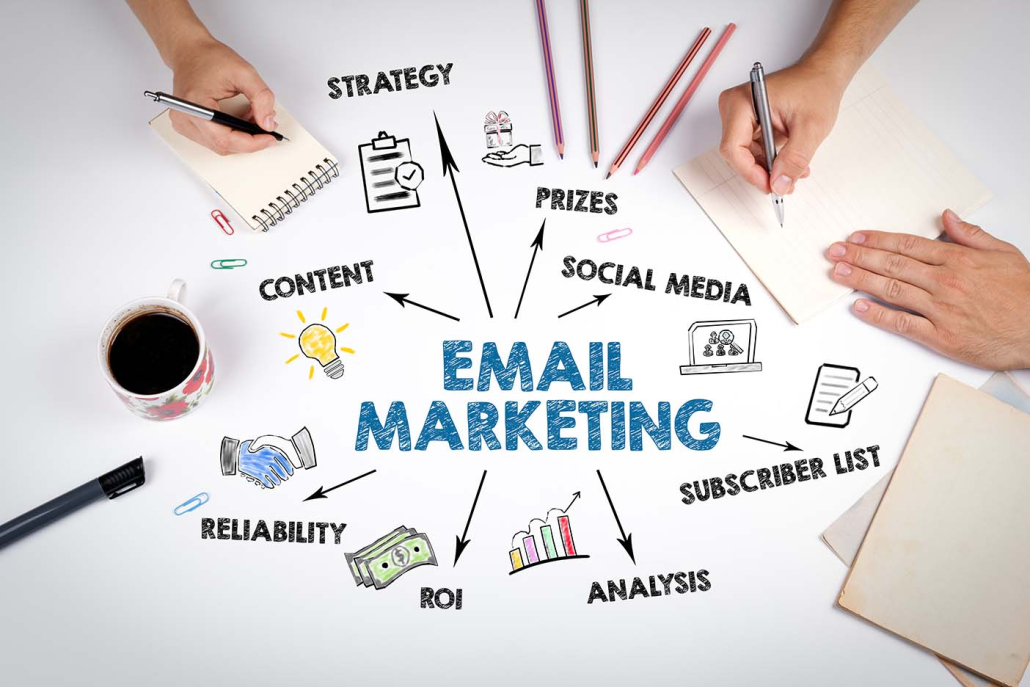This week’s blog is an introduction to email marketing. With the rise of social media, some believe email is “dead”. In reality, email is still essential, and there are over 4 billion email users daily and most customers prefer to receive communications from brand by email. Email marketing is an incredibly important tool for reaching and communicating with your audience, community, customers, or clients and keeping them engaged. We’re going to provide you with some essential starting tips for effective email marketing.
Email Marketing Platforms We Recommend
If you have any experience with email marketing, you’re familiar with email marketing platforms. These help you create emails and campaigns, manage your audience, set up automations, and more. They make email marketing possible and effective. The best ones have toolsets to create visually impressive and gripping emails and tailor specific parts of your audience. Today, there are countless services out there and most offer comparable functionality so here are our top picks. We ultimately recommend testing out the email builders and automation tools in each to see which you prefer. Those listed here are all free to try with advanced functionality behind premium plans.
- MailChimp
- Klaviyo
- Drip
Create Templates
Every email marketing platform will let you create templates. These provide a basic structure for you to insert content. With these as a foundation, you will significantly cut down on the time needed for making emails. If you regularly send different kinds of emails, build a template for each. Use some variety to prevent them from being identical but ensure each also matches your branding for visual continuity and recognition. Consistent templates will also improve that recognition between your emails.
Piquing Subject Line
Most inboxes receive a torrent of emails daily, with a large portion of those going right to the trash. For effective email marketing that gets clicks, you first need opens. That means you need an enticing subject line. Effective email marketing uses subjects that create urgency and kindle curiosity to encourage opens. Using words and phrases like “still time”, “expiring”, “last chance”, or enticing questions will quickly generate more opens. Be careful about certain other words like “Winner”, “Cheap”, “Satisfaction”, or “100% Free”. These can immediately trigger spam filters.
Personalization
An extremely effective way to generate opens is to personalize emails. A personalized subject line can increase open rates by 50%! When having people signup to your newsletter or audience, try to collect their first names in a website popup or signup in your website’s footer. If your email marketing platform is hooked into your website’s back end, it will be able to then add their names into the subject line or email body to create a more personalized touch.
Call to Action
It’s great if you are getting good open rates on your marketing emails. You need to ensure those generate into clicks and, even better, sales. Include call to actions in your email that incite readers to follow through to your website, store, forward the email to others, and complete any other action you are hoping they perform. Simple commands or buttons with “Order now” or “Read More” will direct readers to your desired outcome. For promotional emails, include product or service images that are clickable.
Link Everything
It’s great if your email has call to action that encourage readers to go beyond and visit your business’ social platforms or website, shop for products/services, or subscribe to more emails. However, any call to action also needs to be quick and convenient, else readers are unlikely to follow through. Provide visible and accessible links for readers to easily click and act. Don’t just link text either; add a URL value to any of the images you include in your email. A dead link is a missed opportunity. A logo at the top should link to your website’s home page. A product image or blog image should link and open their respective landing pages on your website. The goal is to make it as easy and convenient as possible for your reader to follow your call to action. Show some restraint though, and do not flood your email with links. Too many URLs in an email will trigger spam filters.
Email Automations
Email automations are useful, and if you have a moderate to large-userbase, completely necessary. They automatically contact your customers and users at certain triggers without you needing to manually write and send them yourself. They can update customers about shipping information, provide product suggestions, and reengage old customers. Without email automations, this would be an infeasible amount of work. If you want to learn more about email automations and the kinds you should start with, check out our blog post here.
Manage Your Audience
Email automations are also a perfect way to manage your audience. At some point, certain members of your audience may become disengaged. They receive but don’t open your emails and haven’t for months. While a larger audience number seem more impressive, a disengaged audience impairs your open and click rates. Users immediately deleting your emails or even marking them as spam can also impair your sender rating, affecting your ability to reach the engaged members of your audience. It’s a good idea to actively try and reengage this disengaged audience. If they still don’t open your emails, remove them entirely. This kind of list cleaning should be done once or twice annually. You can use email automations to do this regularly.
It is also valuable to section off your audience for specific communications. Email marketing services hooked into your store’s backend can create “personas” according to your users’ purchase and browse history to identify their interests. You can then tailor emails to these sections. For example, if you provide various services, you may have some clients who should receive emails about service A while other clients will be interested in emails about service B. This ensures users are receiving communications that matter to them.
Email Marketing Law
Canada’s anti-spam legislation limits to whom you can send emails and what you must include. You specifically need consent from any user to send them emails. For newsletters, this means readers need to be subscribed. However, automated emails like product recommendations or an abandoned cart have consent so long as user purchased or visited your site within the past year. However, there’s still a limit to how many communications you can send, and all emails need to include unsubscribe links so that users can revoke consent at any time. All your emails also need to provide alternative contact information such as your physical address or phone number.
Email Marketing Key Performance Indexes (KPIs)
Lastly, you need to track how your emails are performing. These are tracked with primary statistics called “Key Performance Indexes” or KPIs. An email marketing platform will provide you plenty of data to parse, but not everything might be pertinent and each needs to be interpreted differently. These are the essential email KPIs:
- Clickthrough Rate – The percentage of readers that follow a link in an email.
- Conversion Rate – The percentage of emails that turn into sales or other activity.
- Bounce Rate – The percentage of emails that don’t reach the targeted inbox.
- List Growth Rate – The rate at which the email audience list grows.
- Email Sharing/Forwarding Rate – The percentage of emails that are forwarded or shared to others who did not receive the original email.
- Overall ROI (Return on Investment) – The financial return generated from an email campaign. The simplest formula is: ROI = (Gross Return – Cost of Investment) ÷ Cost of Investment
- Open Rate – The percentage of emails opened.
- Unsubscribe Rate – The percentage of readers who unsubscribed after receiving an email.
More to Learn
There’s plenty to learn with email marketing, but for now we’ll stop the lesson here. If you’re practicing these essential tips, you are already most of the way there. If you have questions or are looking to improve your email marketing, contact us at Rosewood. We’re email experts and provide a variety of email services for any stage of the email marketing process whether your business is ecommerce or service based.






